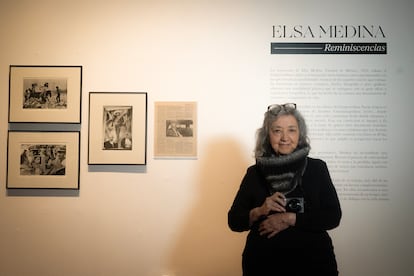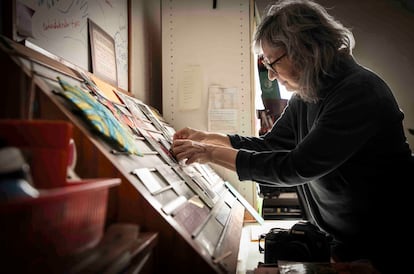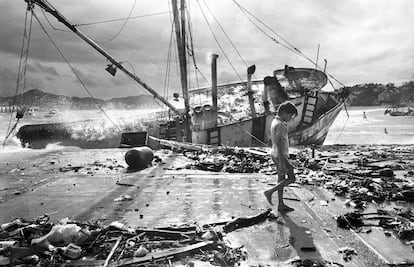The photographer Elsa Medina (Mexico City, 1952) celebrates more than 40 years of work with an exhibition at the Image Center of the Mexican capital that she has titled Reminiscencesa word that for her evokes memory because, she says in this interview, the photojournalism to which she dedicated much of her life is an exercise in memory. The exhibition will bring together a hundred photographs that are just a pinch of his immense archive, so large that he does not know how many images he has. It is stored in dozens of boxes in his house, it occupies the living room, the bedrooms, the shelves. “I’m going to throw it away, give it away, because it doesn’t fit anymore, it’s a very big file,” says Medina.
It is in that art deco-type apartment in the Hipódromo neighborhood where this conversation takes place on a cold and humid morning in the Chilango autumn. Medina throws a shawl over her shoulder to warm herself (“my old lady’s shawl,” she says, laughing) and explains that she is tired after weeks of hard work to prepare the exhibition, which has not been without tragedies: a blackout in her neighborhood affected one of the hard drives that stored part of that graphic memory and it lost all its content. A bad technology joke that is supposed to make our lives easier. Because much of Medina’s work is kept in negatives, those gadgets that now seem like alchemist’s magic.
Medina reviews those decades of work carrying a camera, of those days when he was a correspondent in Tijuana for the newspaper The Dayrecently created in the decade of the late eighties, when I had to rush to the airport to arrive on time before the flight to Mexico City departed. Medina observed the passengers and pondered who could be a reader of the newspaper. Then he would approach him and ask him to carry the negative in his luggage, which someone from the editorial staff was waiting for at the capital’s airfield. Being a young newspaper, The Day It did not yet have the technology to transmit the images. “I never lost a reel,” he says.
She is a witness to history, of Mexico, but also of Latin America, because she has documented political crises in Haiti or the defeat of Sandinism in Nicaragua. The photographer reviews that story, which can also be seen this Saturday at the Image Center, in her reminiscences as a photojournalist.
Ask. What does this exhibition represent for you?
Answer. Son! It is an opportunity to see yourself, to see everything you have done, how it has been. It represents the opportunity to understand that I have been very lucky, because I have worked in the south of Guerrero, in The daythen I was a correspondent in Tijuana. That made me understand that everywhere there is something to do and that brings you closer to human beings.
P. What is photography for you?
R. For me it has been a path of life. Since I started taking photos it was a way of learning to see. I was lucky to have a super teacher, Nacho López, who taught me to see and be critical.
P. What did Nacho López teach you to see?
R. The important thing was to learn from where you see and what you see, because at the end of the day we see what we want. The photo is an awareness. It happened to me that I didn’t know what was worth photographing when I started. Photography is also a way to maintain memory. This exhibition is called reminiscences because when I review my negatives I find things that I didn’t remember. The first photo I have is one I took in elementary school and that I found a few years ago and my first documentary work was in 1980. I entered journalism in 1986.
P. It was in The Day. How was that experience?
R. I thought I couldn’t live without photojournalism, but you can. I enjoyed it a lot, I lived it intensely. It taught me that I know when I’m leaving, but I don’t know when I’m coming back. Photography has always accompanied me, because it is like an addiction. Sometimes I see things and say: ‘oh, it was a photo.’
P. How do you know that that is the accurate image?
R. Photography has a language and you have to learn to look with that language and you have to accompany it, in journalistic terms, with an ideological position and be aware of that.
P. In that way?
R. If you are going to cover a march you have your point of view. I don’t believe journalism is objective, nor what that word means. It doesn’t exist. It’s important to recognize that. Then you learn to see photos. It is an awareness of all kinds: seeing the light, what is happening, making decisions.

P. Does a photojournalist, at the time of his work, have to have any political or ideological commitment?
R. Yes, you have it. The first is the job, where you work. They told me: ‘You take this photo, because they publish it for you.’ I am referring to photos that were not official, especially the political photo, so that the character looked good. One begins to change that, begins to photograph the politician in the House sessions asleep, talking to each other. In The Day We already saw that.
P. ¿God The Day that freedom, taking into account the very official position that the Mexican media had?
R. Of course, everything. They didn’t tell you ‘you have to bring such a photo’. In the Presidency they controlled things a lot, there was a lot of paraphernalia, they put you in the back at official events, but in the newspaper they didn’t force you to have a photo. I took a workshop with Christian Caujolle, photography editor at Liberation! and he told us that they were prohibited from giving official greetings, those with little hands. In addition to freedom, in The Day There was respect for your gaze, because they were clear about what the event was about and what you think and so you try to take a photo that can reflect your point of view.
P. How do you see Mexican photojournalism now?
R. There are excellent jobs. Many young photographers with deep, committed work. The media remains almost the same, because they are companies and they want to sell and have interests. The editorial line is biased towards the interest of the owners. But now reports are being made that were not done before, some of them very dangerous.
P. Of the topics you have touched on in your career, which one has you been most passionate about?
R. I liked social movements, but I also liked photographing politicians, because for me it was like a simulation, giggles, squeezes, and the fact of being able to capture a moment when they expressed another side was important. I also covered many marches, but I didn’t love the elections. I had to cover the return of Guatemalans who were in Mexico, who had fled what happened in Guatemala, which was terrible. The idea was to follow them to the border, but they told me no, to go as far as they go. I brought my passport by chance and was able to document everything.
P. He was also in Haiti at a critical moment…

R. We were there before the coup d’état against Jean-Bertrand Aristide. There are photos of that in the exhibition, with texts from an editor friend. We got excited about the Lavalas movement and we left, because at that time I was very adventurous. We went on our own, the newspaper gave us permission, but didn’t pay anything. I also went to the elections in Nicaragua, when Violeta Chamorro won. I walked into the country from Costa Rica. We were at the convention center The Piñatain Managua, where this guy Ortega was going to declare his victory. I remember that there was a lot of silence in the lines, people already knew that the revolution was not going to continue. I have photos of Chamorro at his house, a day later.
P. Would you return to photojournalism?
R. I do like documenting, but going to events like inaugurations makes me lazy, because I’ve already done it a lot. Going to see what happens somewhere always interests me, but at a different pace.
P. Are there any outstanding issues that you would like to document?
R. I really want to do work about loneliness. It has to do with mine, although I feel very good, but with loneliness in its abstraction, individuals who are alone from the point of view of what you feel, what you think, what you live. In the middle of this bustle we are alone, stuck in the machines. Look what’s happening with these young people who call incelswho live hell. Because society rejects you, it demands that you have certain ways of seeing yourself. There is economic frustration and the means that make the world beautiful for you. Furthermore, I know many friends, men and women, who live alone and that topic interests me as a situation that is happening in this world.

